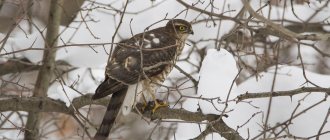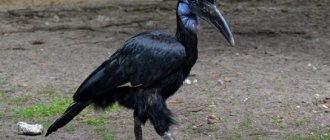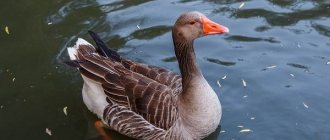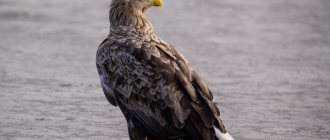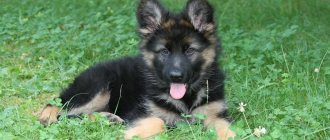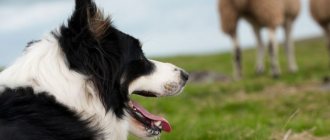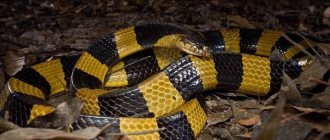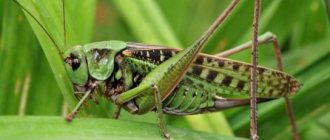Common characteristics of all types of owls
Predatory nocturnal representatives of birds are very numerous. There are more than two hundred species of owls in different directions of the world. Ornithologists identify common characteristics that distinguish owls from other birds:
- Amazing owl eyes lack eyeballs. These are eye tubes held in the skull by special bone structures. Therefore, the huge, penetrating eyes are motionless. Birds look forward with both eyes at once, determining the distance and mass of the prey when hunting. With phenomenal farsightedness, the owl sees objects close to it poorly. “Night vision devices” are protected by three eyelids - one blinks, the other maintains cleanliness, and the third serves for sleeping.
Structure of the owl skull
- However, the static nature of the eyes is more than compensated for by the mobile neck. The angle of rotation to the left and right is 1350 thanks to the 14 cervical vertebrae and the special structure of the blood vessels.
- Owls also have excellent hearing. Asymmetrical auditory openings, often of different sizes, do not catch sound waves synchronously. The distance to the source of the slightest rustle is determined with amazing accuracy.
- The owl has discovered where and what kind of prey is hidden, now the task is to fly up silently. Wide wings with a soundproofing border on the feathers leave no chance for the prey to hear the approach of the hunter. The camouflage color blends the bird with the surrounding nature.
- The grip of owls' paws is deadly. Typically, three fingers point forward and one back. In flight, one front finger turns back. It turns out to be a “dead grip”.
This is how, in the process of evolution, ideal feathered hunters appeared on Earth more than 50 million years ago. The order of owls is divided into two families - true owls and barn owls. These include eagle owls, scops owls, tawny owls, and long-eared owls.
The grip of an owl's paws is called "deadly"
The dangers that await them
Being tiny creatures, they are constantly at risk of becoming prey to larger predators themselves. In the desert, snakes and coyotes and lynxes are ready to hunt them. Large owls and hawks will not refuse to snack on their relatives.
Elven owls are not aggressive, preferring to hide rather than attack. Therefore, they are happy to use cacti in which they can safely hide. And it is also noted that they use a hackneyed technique. If an owl is in danger, it falls to the ground and freezes. The coloring allows you to completely merge with the landscape.
But today they face a different danger. Man is trying to use every hectare of land, cutting down coastal forests. The climate of these places is changing. The use of pesticides leads to a critical decrease in the number of insects that charming owls feed on.
Source
Representatives of the genus scoop
The family of real owls is divided into three dozen genera. Within each genus there is a gradation by species. The noctuid genus includes more than 50 species, distinguished by their reddish-brown or variegated gray color.
Type of scops owl
Birds with a body length of up to 20 cm and a weight of up to 130 grams owe their original name to their melodic call sign “sleep-yu-yu”.
Listen to the voice of Scops Owl
The migratory species of owls prefers to spend the winter in African savannas. The period from March to October is spent in Lake Baikal, southern Siberia, Asia Minor and Central Asia, and the Middle East. In Europe, scops owls have chosen the olive groves of the Mediterranean.
They settle in rock crevices and hollows. Sometimes they occupy the nests and burrows of other birds - magpies, kingfishers and bee-eaters. The diet consists of beetles and moths, less often small frogs and lizards. They live up to 5-6 years in the wild.
Thanks to its variegated plumage, Scops Owl can be difficult to notice in forest thickets.
Collared Owl
On Sakhalin, the Kuril Islands, and the south of Primorye you can find an owl weighing up to 200 grams and with a characteristic light spot on the neck, for which they are nicknamed “collared”. They live sedentary in cedar, fir or mixed forests.
They hunt small rodents and birds, and in summer they catch night bugs and hawk moths. Snowy, harsh winters force birds to nest closer to humans. They settle in attics, exterminating rats and mice.
Cutworms can settle near people, helping to fight rodents
Owner reviews
Owls have a rather “subtle” character, so they have a very negative attitude towards any changes in their lives. This bird quickly gets used to its owner and, in the event of a long separation, may completely refuse to eat. She gets used to the one who feeds her, and she will not take food from the hands of another person.
The owl has a fairly powerful and sharp beak, as well as claws, so it can easily injure those who play with it. If there are other animals in the house, then this is a whole problem. The problem also manifests itself with the onset of the mating season of owls, as they begin to make loud calls, both during the day and at night.
It's important to realize! Even in ancient times, the cry of an owl was considered a song of death, symbolizing grief and loneliness. Therefore, the most important thing is to prepare not only physically, but also mentally for the appearance of such a pet at home.
The best option is to feed the owl live, and not just frozen foods, in the form of rodents, reptiles, worms, etc. In this regard, many owners of domestic owls buy live pigeons, sparrows, rodents, rabbits, etc. Owls are considered nocturnal predators, so their feeding should occur at night.
What is known about the genus of owls
The interpretation of the word “tawny owl” is currently twofold. Some sources refer to the voracity and insatiability of the birds themselves. Others associate the outlandish designation with the inability for a person to eat tawny owl meat as unclean. The numerous genus of these owls includes more than 20 species distributed throughout the world.
Gray owl
The tawny owl adapts well to a variety of natural conditions. They inhabited forests from the Mediterranean Sea to the taiga south. Appearance of an owl from the genus Tawny Owl: a bird with a body length of up to 40 cm and a weight of 500 - 650 grams has plumage the color of tree bark. The wings are relatively short and rounded. Can hunt fairly large birds such as rooks and small animals. During the mating period, males attract females with howling loud hoots.
Listen to the voice of the gray owl
Pallid owl
It settles further south, in palm thickets and rock crevices in the deserts of Egypt, Israel, and Syria. At night it hunts mice and large insects. Approximately 30-35 cm in size, pale colored, light yellow eyes.
Great Gray Owl
A large bird with a length of up to 80 cm and a wingspan of up to one and a half meters. A specific feature of these predators is a black spot under the beak, similar to a beard. They live in Primorye, Transbaikalia, the Baltic states, and western Chukotka. There have been cases of appearance in the Volga forests near Cheboksary. Included in the Red Books of a number of regions of Russia.
Many species of tawny owl are listed in the Red Book
How does she look
Petite and cute, it is a common inhabitant of coastal desert areas. This is the smallest of all the owls in the world. Of course, elves have nothing to do with her. I just wanted to emphasize its peculiarity with this name. It can also be given the title of the lightest owl in the world, because its weight is approximately 40 g. Their dimensions are tiny, an adult reaches 14 cm in length, and the wingspan does not exceed 27 cm. If you keep owls at home, then only elven ones. It is not so difficult for them to get food, because they eat almost any insect.
A unique genus of eagle owls
Nocturnal birds with pronounced characteristic feathered “ears” inhabit both Americas, Eurasia and Africa.
Common eagle owl
The common eagle owl has become a living symbol of the game show for connoisseurs. Distinctive features of eagle owls:
- large stocky body 60-75 cm long and wingspan from 1.6 to 1.9 m;
- females weighing from 3000 to 3200 grams are larger than males weighing only 2000 -2700 grams;
- bright orange “piercing” eyes;
- interspersed with orange-brown tones of feather color.
The sedentary live in the forests and steppes of Asia and Europe, feeding on hares, hedgehogs, and rodents. They catch ducks, chickens, crows. They grab them in flight, hit them on the nest, and sometimes even dive for fish. Small game is swallowed alive, larger prey is torn to pieces. Hedgehogs are stripped of their needles, but not always.
There are known cases of eagle owls attacking muskrats and nutria. The loud calling hoot of an eagle owl in the pre-dawn hour spreads 3-4 km around. When worried, the birds make an eerie “laugh.” The rich sound arsenal of common eagle owls includes mournful crying and humming.
Fish owl
Lives in the Far East, unfortunately, being in danger of extinction. The fish eagle owl is distinguished by its massive body size of up to 700 mm and its immense wingspan. Some females gain weight up to 4 kg. The feathers are brown with black specks. There is a light spot on the neck.
Not only the appearance of the birds is unusual, but also their way of life. For food, they catch fish, mainly salmon, weighing up to 1 kg. When hunting, a fish owl dives from the air or goes belly-deep into the water.
In addition to fish, it does not disdain frogs and crayfish. A diurnal species of owls, as they are active in winter during daylight hours. The amazing fish owl wanders a lot on the ground, trampling down entire paths.
The fish owl is a very large bird, some individuals can reach 4 kilograms
polar owl
The white or polar owl inhabits the tundra, surpassing in size other owls of this region. Females measuring 70 cm weigh 3 kg. Males are smaller - 60-65 cm and 2-2.5 kg. The appearance of the white owl is impressive - snow-white plumage with black splashes, orange eyes on a large round head. The feathers on the legs hang down like shaggy wool for protection from frost.
An active twilight predator soars in the air or sits on an elevated surface, looking for prey. The claws can catch mice, lemmings, hares, stoats, partridges, and ducks. When hungry, it picks up carrion and catches fish. However, the polar owl does not hunt near its nest. Geese, geese, waders, and ducks fearlessly build nests in the territory protected by the owl from arctic foxes.
The extraordinary appearance of the snowy owl inspires people to use its image. The polar bird adorns the coats of arms of Norilsk and New Urengoy. A popular writer made a white owl the personal postman of a boy wizard.
Keeping at home
A small apartment is not suitable for keeping a predator. If possible, the bird is given a separate spacious room.
A domestic owl should live in an aviary.
It can be made from metal rods. The bird will fly calmly in the aviary.
A private country house is the most suitable place for a nocturnal bird to live. It’s good if the enclosure is located in the yard.
It is not advisable to keep them in a cage.
This will create discomfort for the owl. The pet may be injured in the cage (broken wings, damaged wax).
If your feathered pet is given a separate room, it needs to be properly equipped.
The windows are covered with thick dark curtains.
You should not keep the “eye-catcher” in the dark 24/7. The sun's rays should sometimes enter the room.
Supports are installed on the walls. Something like tree branches. Such supports are called “perches”. It would also be nice to arrange a kind of hollow. It can be made from a small box.
The floor is covered with newspapers. This makes the cleaning process easier.
During taming you will have to put up with scratches and abrasions.
Regardless of your feathered pet's mood, its beak and claws will cause damage to the skin.
Genus of long-eared owls
Long-eared owls are divided by ornithologists into 6 species, the unifying feature of which is the long, upward-protruding feathers above the auditory openings.
Long eared owl
The appearance of the long-eared owl speaks for itself - ear tufts of six feathers are clearly visible on its head. Birds measuring 35-37 cm inhabit Eurasia and winter in Africa. They feed on small birds, rodents, and insects. They are not afraid of people and are found in coniferous parks and groves near villages.
Short-eared owl
A close relative of the long-eared owl loves wet lowlands and the outskirts of swamps, where it attacks mice, small birds, frogs, and insects. But the short-eared owl’s “ears” are short and inconspicuous. The short-eared owl lays its eggs in a hole lined with moss.
Annual migration
Experts began studying this species of bird and discovered interesting facts about them. It turns out that during the year they migrate over considerable distances. This is due to the harsh characteristics of the region. In spring and fall they are found in the arid deserts of northern Mexico. There they breed and raise their young. They inhabit mainly areas where there are many cacti and tree canyons. They migrate south during the winter, spending the colder months in the warm coastal areas of Mexico.
Genus pygmy owls
Owls of this genus are small, their wings are short, and their tail feathers are long. The color is reddish-brown, with dark and light dots. Why not sparrows? There are as many as three dozen species of such “sparrows” within the genus.
Great Sparrow Owl
The only species of small owls living in Russia is the great owl. Its size is only from 150 to 200 mm and its weight is no more than 500-800 grams. The yellow eyes of the pygmy owl are surrounded by chocolate circles, and white eyebrows hang over the top.
Despite its modest size, the pygmy owl is a brave hunter. Boldly swoops down on living creatures equal in size to it - mice, rats, lemmings, partridges. The gourmet from the owl family immediately eats the brain and eyes of the victim, and stores the rest of the carcass in a hollow for a “rainy day.” The pygmy owl is also not lacking in cunning. In winter, it waits in ambush at feeders, lying in wait for titmice, sparrows and bullfinches.
Owls are also familiar with “swan loyalty.” They form a pair once in their entire life. While the chicks are hatching, the father owl touchingly feeds his female. A family nest nestles in an abandoned woodpecker nest.
External links [edit]
| Wikimedia Commons has media related to Athena Noctua . |
- Little Owl: Videos, Photos and Sounds on the Internet Bird Collection
- Little Owl nesting cameras in the Netherlands
- Little owl in New Zealand
- Aging and sex determination (PDF; 5.5 MB) Javier Blasco-Zumeta and Gerd-Michael Heinze
| Taxon identifiers |
|
| Authoritative control |
|
Barn owl family
Another family of the owl order is the Barn Owls. The table shows the specific differences between barn owls and real owls.
| Sign | Real owls | Barn owls |
| Facial disc | round | cordate |
| Eye color | yellow orange | black Brown |
| Head shape | round, massive | elongated, graceful |
| Body structure | barrel-shaped, stocky | slim |
| Wings | wide, rounded | long, sharp |
| Paws | short, powerful | extended |
The Barn Owl family is divided into a pair of genera, within which there are up to 19 species.
Interesting Facts
Ornithological scientists have long come to the conclusion that owls belong to an independent order and have nothing in common with other feathered predators. Sometimes they even differ from each other: some hunt at night, while others hunt during the day. All owls have different degrees of calls with which they communicate: a calling call for mating, dialogue between two males, and also the squeaking of small owlets that want to indicate their location.
At all times, these birds were treated ambiguously: among some peoples they were considered a bad sign and a harbinger of something bad, while among others they were considered a symbol of wisdom.
Types of owls
Genus masked barn owl
Exotic owls are native to Southeast Asia and Africa. They are small in size compared to other barn owls. Stiff feathers along the edges of the facial disc form a kind of mask. At night they go out to hunt for small animals - rodents, birds, insects.
Nutrition
When it comes to food, the Scops Owl has its own preferences. Since it is a predator, it must receive animal food in its diet every day. When free, they catch small rodents, but at home they eat meat well. But remember, this should not be store-bought meat, since digestion can overcook this meat. It is best to give preference to domestic chickens. Earthworms and insects can serve as additional treats. In addition, they need vitamins. For example, berries, vegetables, fruits and so on. These products are really necessary for the scops owl's health and immunity. It is necessary to introduce ingredients into the diet gradually and carefully, since Scops Owl is a very picky eater.
Barn owl genus
A larger and more numerous genus than masked barn owls. The color of the feathers is “dark top, white bottom”. Ancient rare species of owls of the barn owl genus have survived on the Australian continent.
Barn owl
Barn owls are ubiquitous and have not colonized only Antarctica. In Russia they found shelter in the Kaliningrad region. Medium-sized birds ranging from 30 cm to 39 cm weigh from 200 to 700 grams. The Russians nicknamed them barn owls for the hoarse, snorting sounds they make during mating. Barn owls are unpretentious, but are not able to accumulate subcutaneous fat and therefore avoid cold climates.
However, they are also not attracted to hot, dry deserts. Barn owls like grassy meadows along water bodies, areas of open forest, and the edges of swamps. During the day they usually sleep in a dry hollow or in the attic of an empty house. With the onset of darkness, they fly out for prey, which is any small living creature.
Madagascar barn owl
Representatives of an endangered species have been discovered in the rainforests of eastern Madagascar. Smaller than an ordinary barn owl, the plumage is red and yellow, with sparse spots, the tail is long. Most of their habitats have been destroyed by people, so unique birds are on the verge of extinction.
Celebes barn owl
A little studied species of small owls from Indonesia with a characteristic reddish facial disc. They are found in forests along the slopes of mountains and hills in the north of Sulawesi. The exact number has not been determined.
Owls bring benefits to people by exterminating crop pests. Some farmers specifically introduce birds of prey. Owls are kept in private and public zoos, living in captivity longer than usual in the wild.
Inventive Japanese have opened establishments where you can not only drink a cup of coffee, but also pet a real owl. Visitors are happy, and animal rights activists are sounding the alarm, considering such cafes a complete disgrace.
Links[edit]
- ^ a b BirdLife International (2012). "Athena Noctua". IUCN Red List of Threatened Species
.
2012
: e.T22689328A40420964. DOI: 10.2305/IUCN.UK.2012-1.RLTS.T22689328A40420964.en. - ^ abcdef Witherby, H. F., ed. (1943). Handbook of British Birds Volume 2: From Songbirds to Owls
. H. F. and G. Witherby Ltd., pp. 26–27. - ^ ab "Little Owl (Athena noctua)". British Trust for Ornithology. January 16, 2013. Retrieved October 14, 2015.
- ↑ abcde Lewis, Dean (August 9, 2013). "Owl: Athena Noctua". Owl Pages
. Retrieved October 15, 2015. - ^ abc Baker, E. C. S. (1927). Fauna of British India. Birds . 4
(2nd ed.). Taylor and Francis, London. pp. 441–443. - Staggenborg, J.; Schaefer, H. M.; Stange, C.; Naef-Daenzer, B.; Grüebler, M. U. (2017). "Time and travel costs during chick rearing as a function of habitat quality for little owls Athene noctua
."
Ibis
.
159
(3):519–531. DOI: 10.1111/ibi.12465. - Fink, Peter (1990). "Seasonal variation in territory size with the owl ( Athene noctua
)".
Oecologia
.
83
(1):68–75. DOI: 10.1007/BF00324636. PMID 28313245. S2CID 25565240. - Hardouin, Loïc A.; Report Card, Pierre; Bretagnol, Vincent (2006). "Recognition of neighbor and stranger in the owl Athena noctua
".
Animal behavior
.
72
(1):105–112. DOI: 10.1016/j.anbehav.2005.09.020. S2CID 53195354. - Perrig, M.; Grüebler, M.U.; Keil, H.; Naef-Daenzer, B. (2017). "Survival of post-fledging Little Owls Athene noctua
in relation to nestling nutrition."
Ibis
.
159
(3):519–531. DOI: 10.1111/ibi.12477. - ^ a b Holt, DW; Berkley, R.; Deppe, C.; Enríquez Rocha, P.; Petersen, J.L.; Rangel Salazar, JL; Segars, K.P.; Tree, KL; Kirwan, G.M.; Christie, D.A. (2014). "Owl: Athena Noctua". Directory of the World's Living Birds
. Lynx Editions, Barcelona. Retrieved October 16, 2015. - Van Nieuwenhuyse, Dries; Geneau, Jean-Claude; Johnson, David H. (2008). Little owl: conservation, ecology and behavior of Athena noctua. Cambridge University Press. C. Chapter 2. ISBN 978-0-521-71420-4.
- Eason, Cassandra (2008). Fairytale Creatures, Mythical Monsters, and Symbols of Animal Power: A Sourcebook. Westport, CT: Greenwood Publishing Group. paragraph 71. ISBN 978-0-275-99425-9.
- Jobling, James A (2010). Helm's Dictionary of Scientific Names for Birds. London: Christopher Helm. With. 58, 274. ISBN 978-1-4081-2501-4.
- Pasarile prevestitoare Cultura. Retrieved July 22, 2022.
- "Overzicht in te wisselen biljetten". De Nederlandsche Bank. Archived from the original on December 6, 2014. Retrieved February 9 +2016.
